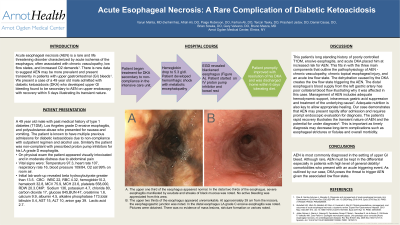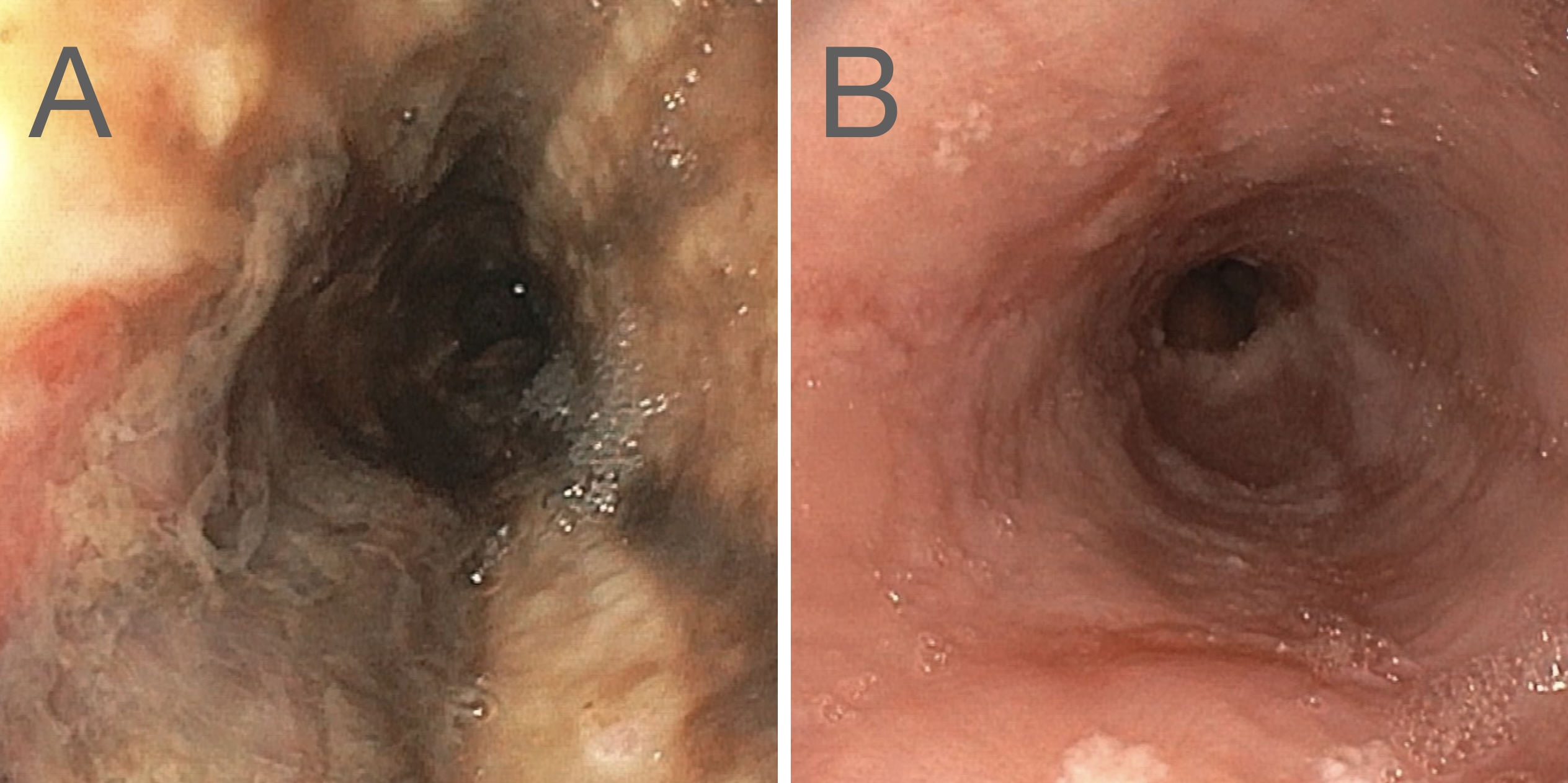Sunday Poster Session
Category: Esophagus
P0524 - Acute Esophageal Necrosis: A Rare Complication of Diabetic Ketoacidosis
Sunday, October 27, 2024
3:30 PM - 7:00 PM ET
Location: Exhibit Hall E

Has Audio
- VM
Varun Mehta, MD
Arnot Ogden Medical Center
West Elmira, NY
Presenting Author(s)
Varun Mehta, MD1, Afrah Ali, DO2, Paige Robinson, DO2, Farhan Ali, DO2, Tenzin Tseky, DO2, Prashant Jadav, DO2, Daniel Casas, DO2, Brian Sowka, DO2, Gary Valvano, DO2, Bruno Mazza, MD2
1Arnot Ogden Medical Center, West Elmira, NY; 2Arnot Ogden Medical Center, Elmira, NY
Introduction: Acute esophageal necrosis (AEN) is a rare and life threatening disorder characterized by acute ischemia of the esophagus; often associated with chronic vasculopathy, low flow states, and increased O2 demands. There is new data to suggest AEN may be more prevalent and present transiently in patients with upper gastrointestinal (GI) bleeds. We present a case of a 49 year old male admitted with diabetic ketoacidosis (DKA) who developed upper GI bleeding found to be secondary to AEN on upper endoscopy with recovery within 5 days illustrating its transient nature.
Case Description/Methods: A 49 year old male with past medical history of type 1 diabetes (T1DM), Los Angeles grade D erosive esophagitis, and polysubstance abuse who presented for nausea and vomiting. Initial lab work-up revealed elevated beta-hydroxybutyrate of 13.5, glucose 845, anion gap 39, hemoglobin 10.2, and lactic acid 2.7. Patient began treatment for DKA secondary to non-compliance in the intensive care unit. Within 24 hours the patient had an acute drop in hemoglobin to 5.3 with coffee ground emesis. Patient developed metabolic encephalopathy and hemorrhagic shock requiring intubation and vasopressor support. Patient underwent upper endoscopy revealing streaks of black mucosa in the distal esophagus (Figure A). He was started on IV proton pump inhibitors and made nil per os. Patient promptly improved with resolution of his DKA and was discharged home within 6 days. On follow-up endoscopy a few months after discharge the patient was noted to have resolution of AEN and improvement in erosive esophagitis (Figure B).
Discussion: This patient’s long standing history of poorly controlled T1DM, erosive esophagitis, and acute DKA placed him at increased risk for AEN given chronic vasculopathy, chronic topical esophageal injury, and an acute low flow state. The distal esophagus’s blood supply from the left gastric artery has poor collateral blood flow illustrating why it was affected in this case. Management of AEN includes adequate hemodynamic support, intravenous gastric acid suppression and treatment of the underlying cause. Our case demonstrates that AEN may present rapidly after admission and requires prompt endoscopic evaluation for diagnosis. The patient’s rapid recovery illustrates the transient nature of AEN and the potential for under diagnosis. This is important as timely diagnosis may decrease long-term complications such as esophageal strictures or fistulas and overall morbidity.

Disclosures:
Varun Mehta, MD1, Afrah Ali, DO2, Paige Robinson, DO2, Farhan Ali, DO2, Tenzin Tseky, DO2, Prashant Jadav, DO2, Daniel Casas, DO2, Brian Sowka, DO2, Gary Valvano, DO2, Bruno Mazza, MD2. P0524 - Acute Esophageal Necrosis: A Rare Complication of Diabetic Ketoacidosis, ACG 2024 Annual Scientific Meeting Abstracts. Philadelphia, PA: American College of Gastroenterology.
1Arnot Ogden Medical Center, West Elmira, NY; 2Arnot Ogden Medical Center, Elmira, NY
Introduction: Acute esophageal necrosis (AEN) is a rare and life threatening disorder characterized by acute ischemia of the esophagus; often associated with chronic vasculopathy, low flow states, and increased O2 demands. There is new data to suggest AEN may be more prevalent and present transiently in patients with upper gastrointestinal (GI) bleeds. We present a case of a 49 year old male admitted with diabetic ketoacidosis (DKA) who developed upper GI bleeding found to be secondary to AEN on upper endoscopy with recovery within 5 days illustrating its transient nature.
Case Description/Methods: A 49 year old male with past medical history of type 1 diabetes (T1DM), Los Angeles grade D erosive esophagitis, and polysubstance abuse who presented for nausea and vomiting. Initial lab work-up revealed elevated beta-hydroxybutyrate of 13.5, glucose 845, anion gap 39, hemoglobin 10.2, and lactic acid 2.7. Patient began treatment for DKA secondary to non-compliance in the intensive care unit. Within 24 hours the patient had an acute drop in hemoglobin to 5.3 with coffee ground emesis. Patient developed metabolic encephalopathy and hemorrhagic shock requiring intubation and vasopressor support. Patient underwent upper endoscopy revealing streaks of black mucosa in the distal esophagus (Figure A). He was started on IV proton pump inhibitors and made nil per os. Patient promptly improved with resolution of his DKA and was discharged home within 6 days. On follow-up endoscopy a few months after discharge the patient was noted to have resolution of AEN and improvement in erosive esophagitis (Figure B).
Discussion: This patient’s long standing history of poorly controlled T1DM, erosive esophagitis, and acute DKA placed him at increased risk for AEN given chronic vasculopathy, chronic topical esophageal injury, and an acute low flow state. The distal esophagus’s blood supply from the left gastric artery has poor collateral blood flow illustrating why it was affected in this case. Management of AEN includes adequate hemodynamic support, intravenous gastric acid suppression and treatment of the underlying cause. Our case demonstrates that AEN may present rapidly after admission and requires prompt endoscopic evaluation for diagnosis. The patient’s rapid recovery illustrates the transient nature of AEN and the potential for under diagnosis. This is important as timely diagnosis may decrease long-term complications such as esophageal strictures or fistulas and overall morbidity.

Figure: A. Acute esophageal necrosis visualized on upper endoscopy for acute GI bleeding during ICU admission for DKA and acute respiratory failure requiring mechanical ventilation B. Resolution of acute esophageal necrosis with baseline LA grade C erosive esophagitis on follow up endoscopy conducted PPI therapy and relatively controlled diabetes.
Disclosures:
Varun Mehta indicated no relevant financial relationships.
Afrah Ali indicated no relevant financial relationships.
Paige Robinson indicated no relevant financial relationships.
Farhan Ali indicated no relevant financial relationships.
Tenzin Tseky indicated no relevant financial relationships.
Prashant Jadav indicated no relevant financial relationships.
Daniel Casas indicated no relevant financial relationships.
Brian Sowka indicated no relevant financial relationships.
Gary Valvano indicated no relevant financial relationships.
Bruno Mazza indicated no relevant financial relationships.
Varun Mehta, MD1, Afrah Ali, DO2, Paige Robinson, DO2, Farhan Ali, DO2, Tenzin Tseky, DO2, Prashant Jadav, DO2, Daniel Casas, DO2, Brian Sowka, DO2, Gary Valvano, DO2, Bruno Mazza, MD2. P0524 - Acute Esophageal Necrosis: A Rare Complication of Diabetic Ketoacidosis, ACG 2024 Annual Scientific Meeting Abstracts. Philadelphia, PA: American College of Gastroenterology.
